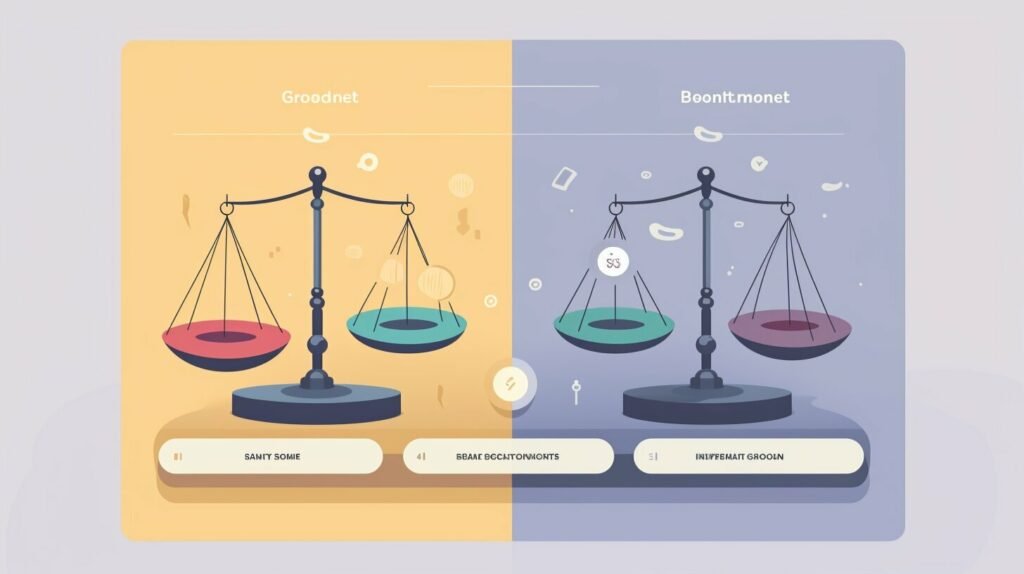As a business owner, evaluating portfolios and client testimonials is an essential process for making informed decisions about service providers. It can provide valuable insights into the quality of work, reliability, and credibility of the service provider. To assess portfolios and testimonials effectively, you need to consider several key factors and strategies.
Key Takeaways
- Portfolio assessment involves evaluating the diversity, quality, and relevance of past projects.
- Client testimonials can influence potential customers and build trust, making them a valuable source of information.
- Establishing clear criteria and maintaining consistency during the evaluation process is crucial to ensure an objective evaluation.
Importance of Evaluating Portfolio and Client Testimonials
Before delving into the evaluation process, it’s crucial to understand why assessing portfolios and client testimonials is essential for your business.
Evaluating portfolios helps you gain insights into the quality of work of the service provider and determine their credibility. By examining their portfolio, you can understand the range of services and industries they specialize in and their level of experience. This information can help you make an informed decision while selecting a service provider relevant to your specific business needs.
Client testimonials provide valuable feedback based on the experiences of previous clients. Potential customers often seek such feedback to make informed decisions and build trust. By analyzing client feedback, you can understand aspects such as the quality of customer support, adherence to deadlines, and the service provider’s ability to meet customer requirements.
Therefore, evaluating portfolios and client testimonials is essential for making informed decisions, gaining insights into the provider’s capabilities, and building trust with potential customers.
 Image Source: seowriting.ai
Image Source: seowriting.aiTechniques for Portfolio Assessment
Portfolio assessment is a crucial component of the decision-making process when it comes to choosing a service provider. There are several techniques that you can use to evaluate a portfolio effectively.
1. Analyze the diversity of projects
When analyzing a portfolio, it’s important to consider the range of projects and services offered. A diverse portfolio demonstrates that the provider has experience working across various industries and can adapt to different requirements. Look for projects that align with your specific needs to ensure that the provider can meet your expectations.
2. Examine the quality of work
The quality of work is a critical factor to consider when assessing a portfolio. Look for evidence of high-quality deliverables, such as well-designed websites, engaging marketing materials, or impactful branding campaigns. Consider the level of creativity and innovation demonstrated in the portfolio, as well as the attention to detail and consistency in execution.
3. Evaluate the relevance of the portfolio to your specific needs
It’s important to evaluate the relevance of the provider’s portfolio to your specific needs. Look for projects that are similar in scope to your requirements, as this demonstrates that the provider has experience delivering similar solutions. Consider the specific skills and expertise required for the projects in their portfolio, and weigh them against your needs.
4. Determine the consistency of performance over time
Finally, consider the consistency of performance over time. Look for evidence of continued success and growth in the provider’s portfolio, as this signals a commitment to excellence and a willingness to adapt and evolve in response to changing industry trends and customer needs.

Analyzing Client Feedback and Testimonials
Alongside portfolio evaluation, analyzing client feedback and testimonials is crucial to making informed business decisions. It helps you understand the provider’s credibility and capabilities and provides insights into the quality of their services.
When assessing customer testimonials, it’s essential to verify their authenticity. Look for testimonials that contain specific project details and results to ensure they are genuine. Consider the language and tone used in the feedback, as it can give you an idea of the client’s satisfaction level.
Another critical factor to consider is the relevancy of the testimonials to your specific needs. If the provider has worked on similar projects, it can indicate that they have relevant expertise. Conversely, if the testimonial mentions work on projects outside of your industry, it may not be as relevant to your needs.
Consistency is another vital aspect to consider when analyzing client feedback. Look for feedback that consistently emphasizes the same strengths and benefits of the provider’s services. If the feedback is consistently positive, it may indicate that the provider is reliable and delivers high-quality work.

“The testimonials provide valuable insights into the provider’s capabilities and reputation.”
Establishing Criteria for Evaluation
When evaluating a service provider’s portfolio and client testimonials, it’s essential to establish clear and objective criteria to ensure consistency and fairness in the evaluation process. The criteria should be based on your business goals, industry standards, and specific requirements. Here are some key factors to consider when establishing your evaluation criteria:
| Factor | Description |
|---|---|
| Quality of Work | Assess the quality of the work presented in the portfolio and customer testimonials. Look for consistency in the quality of work delivered. |
| Experience and Expertise | Review the service provider’s experience and expertise in your industry and the specific services or solutions you require. Evaluate the level of expertise and the range of services offered. |
| Credibility | Assess the credibility of the provider by analyzing customer reviews and testimonials. Look for consistency in feedback across multiple channels. |
| Relevance | Evaluate the relevance of the portfolio and testimonials to your specific requirements. Consider the specificity of the projects or services presented and how they align with your needs. |
| Communication and Responsiveness | Assess the service provider’s communication and responsiveness by reviewing customer feedback. Look for timely and effective communication practices. |
| Price and Value | Evaluate the service provider’s pricing and value proposition. Consider the quality of work delivered in relation to the pricing. |
By establishing clear and objective evaluation criteria, you can ensure consistency and fairness in the evaluation process. It also helps you make well-informed decisions based on your specific business needs. In the next section, we will discuss the key considerations when evaluating a service provider’s portfolio.

Key Considerations for Portfolio Evaluation
When evaluating portfolios, it’s essential to consider a range of factors that can help you make informed decisions and choose the right service provider for your business. Here are some key considerations to keep in mind:
| Factor | Description |
|---|---|
| Range of services offered | Assess the breadth of services offered by the provider, and whether they align with your business needs. Consider whether they specialize in particular areas, or if they have a more general approach. |
| Level of expertise and experience | Examine the provider’s credentials and experience in your field. Look for evidence of successful partnerships and projects, and determine whether they have the necessary qualifications and training to meet your needs. |
| Quality of deliverables | Analyze the quality of the provider’s deliverables, such as completed projects, reports, and presentations. Examine the level of detail, accuracy, and professionalism in these outputs. |
| Adaptability to different industries | Consider whether the provider can adapt their services to meet the needs of different industries and sectors. Look for evidence of versatility and agility in their portfolio and client testimonials. |
| Ability to meet deadlines | Assess the provider’s ability to deliver work on time and within budget. Analyze their track record for meeting deadlines, and examine the strategies they use to manage projects and resources effectively. |
By weighing these factors and prioritizing them according to your specific requirements, you can effectively evaluate portfolios and make informed decisions that support your business goals.

Assessing Client Testimonials Effectively
Client testimonials offer valuable insights into the capabilities and reputation of service providers. However, not all testimonials are created equal. To assess them effectively, you need to consider several factors.
Verify authenticity: Testimonials that are vague or lack details may be fake. Look for testimonials that include the client’s full name and company, or a photo of the client. Reach out to the client to verify the authenticity of the testimonial if possible.
| Authenticity Checklist: | |
|---|---|
| Testimonials that lack details or are too generic | Avoid |
| Testimonials that provide specific details about the project or service | Consider |
| Testimonials that include the client’s full name and company, or a photo of the client | Highly consider |
Language and tone: Pay attention to the language and tone used in the testimonials. Look for testimonials that use specific and descriptive language and avoid those that use generic phrases.
Relevance: Consider the specifics of the projects or services mentioned in the testimonial. Look for testimonials that are relevant to your business needs and goals.
Consistency: Look for consistency in the feedback provided. If most testimonials share a common positive attribute, it is more likely to be true.
By considering the above factors, you can effectively analyze client testimonials and make informed decisions.

Using Portfolio and Testimonial Evaluation to Make Informed Decisions
After conducting a thorough evaluation of portfolios and client testimonials, it’s essential to use this information to make informed decisions for your business. Here are some strategies to help you make the right choice:
- Weigh the evaluation results: Consider the strengths and weaknesses of each service provider based on your evaluation criteria. Look for areas where they excel and where they may fall short.
- Compare different service providers: Create a side-by-side comparison of the service providers you evaluated. This will make it easier to see how they stack up against each other.
- Consider intangibles: While portfolios and client testimonials provide valuable information, don’t forget to consider other factors such as communication skills, responsiveness, and cultural fit.
- Choose the most suitable service provider: Based on your evaluation, select the service provider that best meets your specific needs and goals.
Remember that the evaluation process is ongoing. As your business evolves and your needs change, continue to assess your service providers to ensure they are still meeting your expectations. By using portfolio and testimonial evaluation to make informed decisions, you can enhance your business success and build lasting partnerships with service providers who can help you achieve your goals.

Conclusion
Evaluating portfolios and client testimonials is a crucial step in making informed decisions for your business. By assessing portfolios effectively, you can gain insights into the quality of work and credibility of the service provider. Analyzing client testimonials can help you build trust with potential customers and understand the reputation of the provider.
To evaluate portfolios, it’s essential to use effective techniques such as examining the diversity and relevance of projects, evaluating the quality of work, and determining consistency over time. When assessing client testimonials, it’s important to verify the authenticity of feedback, consider the specifics of projects or services mentioned, and look for consistency in the feedback provided.
Establishing clear criteria for evaluation is crucial to ensure a consistent and objective process. When evaluating portfolios, considerations such as the range of services offered, level of expertise, quality of deliverables, adaptability to different industries, and ability to meet deadlines should be weighed and prioritized. When assessing client testimonials, the language and tone used, authenticity, and consistency should be taken into account.
By using portfolio and testimonial evaluation to make informed decisions, you can compare different service providers and select the most suitable one for your business needs. Remember, ongoing evaluation and adaptation are crucial for maintaining success in the long run.
What are the Key Metrics and KPIs for Evaluating Portfolio Performance?
Metrics and key performance indicators defined play a crucial role in evaluating portfolio performance. They provide a quantitative assessment of various aspects, such as return on investment, risk management, and asset allocation. These metrics include net asset value (NAV), alpha, beta, standard deviation, and Sharpe ratio. By analyzing these metrics, investors can better understand the performance and make informed decisions to optimize their portfolios.
FAQ
Q: Why is evaluating portfolios and client testimonials important?
A: Evaluating portfolios and client testimonials is important for gaining insights into the quality of work and determining the credibility of service providers. It can also influence potential customers and build trust.
Q: What techniques can I use for portfolio assessment?
A: Effective techniques for portfolio assessment include analyzing the diversity of projects, examining the quality of work, evaluating relevance to your specific needs, and determining consistency of performance over time.
Q: How can I analyze client feedback and testimonials effectively?
A: To analyze client feedback and testimonials effectively, consider factors such as the credibility of the source, authenticity of the feedback, and relevancy to your requirements.
Q: What criteria should I establish for evaluation?
A: To ensure a consistent and objective evaluation process, establish clear criteria based on your business goals, industry standards, and specific requirements. Maintain consistency and fairness during the evaluation process.
Q: What are key considerations for portfolio evaluation?
A: Key considerations for portfolio evaluation include the range of services offered, level of expertise and experience, quality of deliverables, adaptability to different industries, and ability to meet deadlines. Weigh these factors and prioritize them based on your specific needs.
Q: How can I assess client testimonials effectively?
A: To assess client testimonials effectively, verify their authenticity, analyze the language and tone used, consider the specifics of the projects or services mentioned, and look for consistency in the feedback provided.
Q: How can I use portfolio and testimonial evaluation to make informed decisions?
A: Use the evaluation results to weigh service providers, compare them, and select the most suitable one for your business needs. Also, remember the importance of ongoing evaluation and adaptation as your business evolves.





